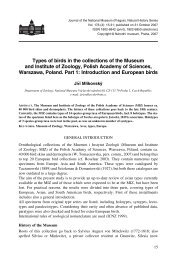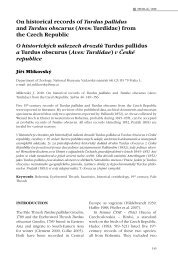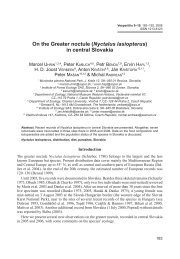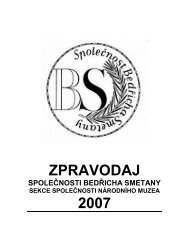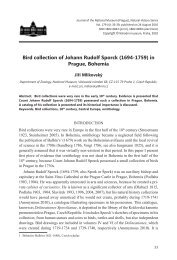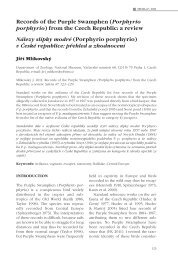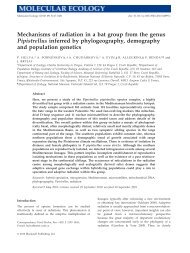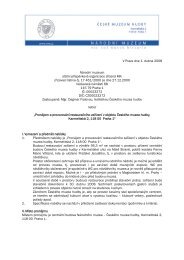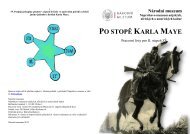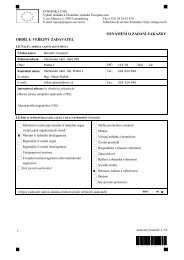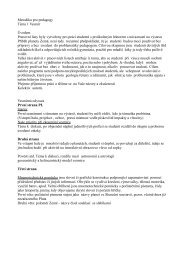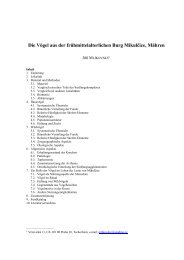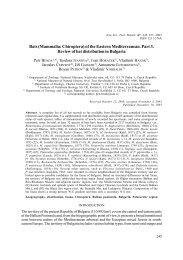Bats (Mammalia: Chiroptera) of the Eastern Mediterranean and ...
Bats (Mammalia: Chiroptera) of the Eastern Mediterranean and ...
Bats (Mammalia: Chiroptera) of the Eastern Mediterranean and ...
Create successful ePaper yourself
Turn your PDF publications into a flip-book with our unique Google optimized e-Paper software.
Fig. 4. Records <strong>of</strong> Rhinolophus ferrumequinum (Schreber, 1774) in Crete.<br />
<strong>and</strong>/or netted in <strong>the</strong> areas not directly related to <strong>the</strong>ir roosts. Pieper (1977) reported findings <strong>of</strong><br />
this bat in owl pellets from three sites in Crete (3.4%).<br />
In eight cases we recorded aggregations <strong>of</strong> R. ferrumequinum representing nursery colonies<br />
(both directly observed <strong>and</strong> indirectly assumed), four <strong>of</strong> <strong>the</strong>m were situated in natural caves<br />
(composed <strong>of</strong> 20–250 inds.), one in a mine (Ano Fortetsa, around 10 inds.; however, this record<br />
is ra<strong>the</strong>r related to a transient aggregation), <strong>and</strong> three in ab<strong>and</strong>oned buildings (20–500 inds.).<br />
Winter aggregations <strong>of</strong> bats were recorded solely in natural caves (at least in 13 cases, besides<br />
<strong>the</strong> records <strong>of</strong> wintering solitaries), <strong>the</strong>y were composed <strong>of</strong> up to 330 individuals (on average<br />
85 inds.). However, no true hibernants were found in <strong>the</strong> Nykteridospilios cave at Ano Asites<br />
studied comprehensively by Galanaki (2006), or elsewhere in <strong>the</strong> isl<strong>and</strong>.<br />
R. ferrumequinum is <strong>the</strong> most widespread bat in Greece (Hanák et al. 2001), it was recorded<br />
in all geographical parts <strong>of</strong> <strong>the</strong> country, including nor<strong>the</strong>rn <strong>and</strong> sou<strong>the</strong>rn mainl<strong>and</strong> regions <strong>and</strong><br />
many isl<strong>and</strong>s; Hanák et al. (2001) reviewed records from Thasos, Lesbos, Skyros, Euboea, Siros,<br />
Paros, Kos, Rhodes, Crete <strong>and</strong> Corfu. Von Helversen (in Mitchell-Jones et al. 1999) mentioned an<br />
additional unspecified record from nor<strong>the</strong>rn Cyclades (Andros/Tinos). Mitchell-Jones et al. (1999)<br />
showed this bat to be widely distributed in <strong>the</strong> European <strong>Mediterranean</strong> <strong>and</strong> sub-<strong>Mediterranean</strong>,<br />
including numerous isl<strong>and</strong>s (Mallorca, Menorca, Corsica, Elba, Sardinian archipelago, Sicily,<br />
Malta, many Dalmatian isl<strong>and</strong>s). In Cyprus, R. ferrumequinum was found to be <strong>the</strong> fourth most<br />
common bat (Benda et al. 2007), though occurring in ra<strong>the</strong>r more elevated areas than in Crete.<br />
TAXONOMY. Miller (1912) was <strong>the</strong> first to evaluate Cretan samples <strong>of</strong> R. ferrumequinum <strong>and</strong> attributed<br />
<strong>the</strong>m to <strong>the</strong> nominotypical form. Ondrias (1965) assigned all <strong>the</strong>n Greek records including<br />
<strong>the</strong> Cretan ones to this form too. Felten et al. (1977) included one specimen from Crete in <strong>the</strong>ir<br />
analysis <strong>of</strong> <strong>Mediterranean</strong> populations <strong>and</strong> made <strong>the</strong> same conclusion as <strong>the</strong> previous authors.<br />
Iliopoulou-Georgudaki & Ondrias (1986) compared a sample <strong>of</strong> 17 specimens from Crete to<br />
literature data <strong>and</strong> <strong>the</strong>ir own samples from mainl<strong>and</strong> Greece; on <strong>the</strong> basis <strong>of</strong> differences in nine<br />
cranial <strong>and</strong> external dimensions as well as in pelage coloration – Cretan samples were found to be<br />
relatively small <strong>and</strong> pale – <strong>the</strong>y described a separate subspecies, R. ferrumequinum creticum (type<br />
locality: Cave “Milatos” [= Milatou cave], Lasithi, Crete). Since <strong>the</strong> authors did not specify <strong>the</strong><br />
name creticum as a noun, its form should be corrected to creticus according to <strong>the</strong> generic name<br />
114



